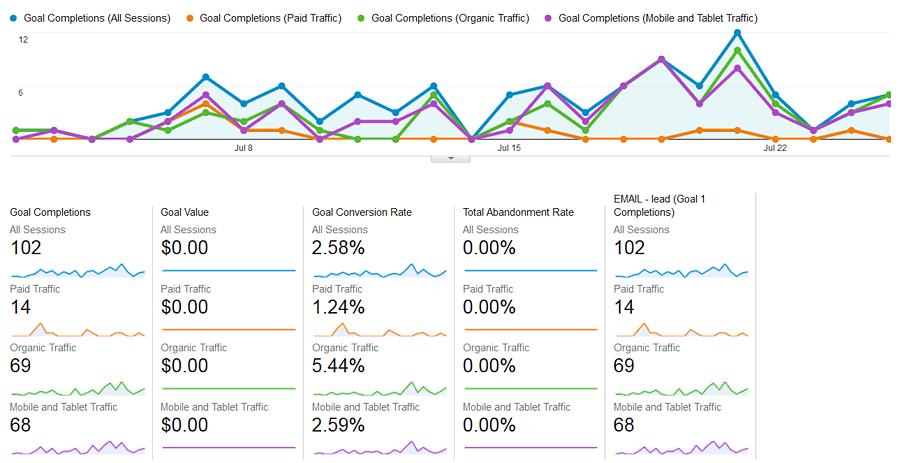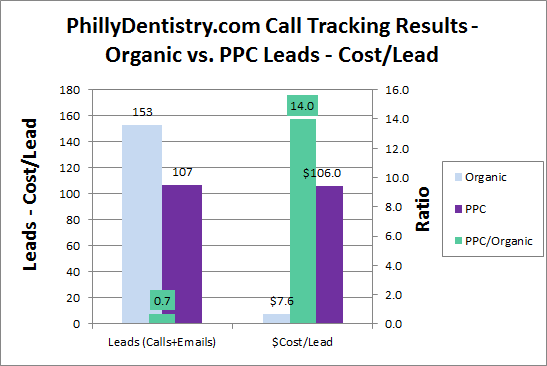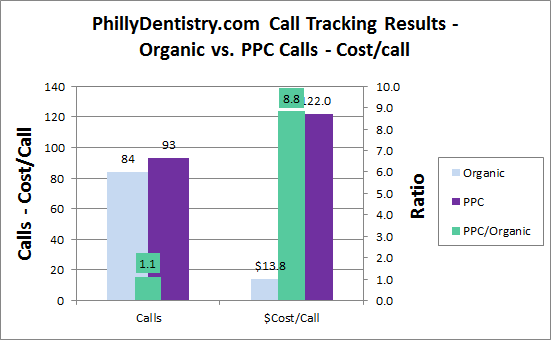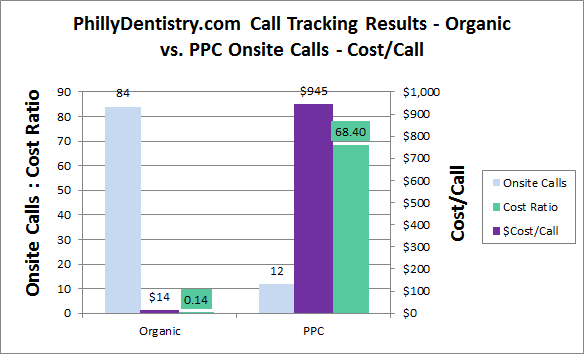The ultimate product of online marketing efforts are leads. Traffic and rankings are nice, but calls and emails are what drive more customers from websites. This article shows how call tracking can help optimize your marketing budget to maximize leads and minimize overall cost.
How Phone Call Tracking Works
Phone call tracking shows site owners which channels drive phone calls from their websites. Using a small snippet of JavaScript phone call tracking software dynamically changes the default number to different phone numbers (local or 800) based on the referral source (i.e., PPC, Natural, or Direct). The tracking numbers redirect to the main business phone number. This technique is called source-level tracking. Typically there is one phone number allocated per source. To add another source, say Facebook, you just add another phone number. Keywords can be tracked with additional phone numbers.
The tracking software records data about the phone calls, which can include source, location, duration, and even record the calls. By attributing the source of phone calls to different channels, site owners can see which channels are the most cost effective at driving phone calls and allocate their resources accordingly.
Setting Up Call Tracking
There are a number of call tracking solutions available, including Mongoose Metrics (now DialogTech), Call Rail, and others. What most of these call tracking services have in common is a cost per minute model on top of monthly service fee. In this example we used a home-grown solution which eliminated the cost per minute component. To setup call tracking, you place a snippet of JavaScript before the closing </body> tag that “flips” the default phone number to a tracking number:
<script type="text/javascript" src=".../ct/referrer_dynjs.php?c_id=65"></script>
Next you surround each (non-fax) phone number with a <span></span> tag thus:
<span class="tele">215-568-6222</span>
That’s it! Now once a user accesses your site, the phone number will change depending on the source (say Google natural, Google PPC, and direct).
PhillyDentistry.com Call Tracking
Dr. Ken Cirka of PhillyDentistry.com kindly volunteered to use let us use his results for this case study. After less than a month of tracking phone calls, the results for PhillyDentistry.com are shown in Figure 1.
The blue (2300) line are Google Natural calls, the orange (1800) line are direct calls (bookmarked, link, direct), and the red (8300) line are Google PPC calls. You can see the organic calls dominate the paid calls (more on this later).
Google Adwords Call Tracking
To capture all the calls from Dr. Cirka’s online marketing campaigns we enabled call extensions and forwarding numbers on Google Adwords. These “off-site” calls come from people manually calling the phone number from the ad, or clicking on the ad’s phone number on a mobile device. 81 calls were generated from PPC ads on Google, 73 of which were from smartphones, and 8 from desktop computers.
Email Leads Generated
During the same time period, we used Google Analytics to track email leads generated by the PhillyDentistry.com website.
A total of 102 emails were generated from the website during the time period in question. 69 of which were from organic traffic, 14 from paid traffic, and 19 emails were from direct traffic. Note that 68 emails were from mobile devices. Note also that the conversion rate of organic traffic was 4.38 times greater than PPC traffic (5.44% vs. 1.24%).
Cost Per Lead
Putting it all together let’s calculate the cost per lead and cost per call. Figure 3 shows the cost per lead (calls + emails) for both organic and PPC advertising.
Each organic lead costs $7.60 and each PPC lead costs $106, some 14 times more than natural. The leads section shows that even though Dr. Cirka is spending 9.8 times more on PPC than natural, he is getting only 70% of the leads that natural generates (107 leads for PPC vs. 153 leads for natural). We attribute the better performance of natural PR to PPC to the higher conversion rate of natural versus PPC (4.4X more likely to email, and 6.2X more likely to call onsite), the higher preference for selecting natural results on search engines (70-85% click on natural results vs. PPC), and the trend we’ve seen of increasing PPC cost per click versus the decreasing cost of natural SEO leads over time as backlinks accumulate.
Cost Per Call
Figure 4 shows the cost per call for PhillyDentistry.com. The cost for a PPC call (both on and off-site) is $122 per call, while the cost per call for natural is $13.8, some 8.8 times less than PPC.
Cost Per Onsite Call
Looking at only the calls generated from the website the difference is nearly 8 times larger. The cost of an onsite PPC call is $945, while the cost of an SEO call is only $14, a ratio of 68.4 to 1.
Mobile Results
65.2% of the visitors to phillydentistry.com were on a mobile device, and 66% of the email leads were from mobile. For PPC advertising, 90.1% of the calls were from smartphones, and 9.9% were from desktop computers.
Highlights from the Study
Some highlights of this study are as follows:
- A PPC lead costs about 14 times as much as a natural lead
- A PPC call costs 8.8 times as much as a natural call
- Onsite, a natural visitor is 6.2 times more likely to call than a PPC visitor
- Organic visitors are more engaged: – they stay 2.4 times as long, email 4.4 times more often, and view 1.5X more pages than PPC visitors. Organic visitors also go deeper into the site than PPC visitors.
- 90% of the PPC ad calls are from smartphones (about 10% from computers [laptops/desktops])
- Mobile first: 65.2% of the visitors are on a mobile device, and 66% of email leads are from mobile
- Direct visitors account for 55% of onsite email leads (last action), and social visitors 5%
Recommendations
Our recommendations are as follows:
- Shift PPC budget to natural (more cost effective)
- Tilt remaining PPC budget to mobile ads (say 75% mobile smartphones/25% desktop computers)
- Categorize smile gallery, blog, and testimonials to give more service-specific pages to index.
Conclusion
Based on this lead tracking data, it is clear that organic advertising is more efficient than PPC advertising at generating leads. In fact, in this case a PPC lead cost about 14 times more than a natural lead. Dr. Cirka could actually spend less money and get more leads by shifting some of his PPC budget to natural, and shifting his remaining PPC budget to mobile ads.
Further Reading
- Attention Dentists: Get More Patients with Internet Marketing for your Dental Practice
- Found that the cost per natural visitor decreased over time as backlinks accumulate. Also found that PPC leads cost on average 3 to 5 times more than natural leads, and PPC cost per lead tends to increase over time as more businesses join adwords and bid up the price.
- CallRail.com
- Offers phone call tracking, recording, and analytics.
- Case Study: Responsive Design of PhillyDentistry.com Results
- A new responsive design improved key metrics for both desktop and mobile visitors. Engagement metrics improved and lead generation increased by nearly 15%.
- Dialogtech.com
- Call tracking software from Mongoose Metrics to optimize your desktop and mobile spend.
- PhillyDentistry.com
- The subject of this article. Dr. Ken Cirka tracks phone calls on this site to optimize his advertising spend.
- Upgrade to a Faster Server: Results
- We further explore the results of upgrading to a faster server. Overall the site showed improved response speed and website “stickiness.” Average page load times improved by 48% to 60% server response times improved by more than 60%, and people stayed longer, viewed more pages, and bounced less.




